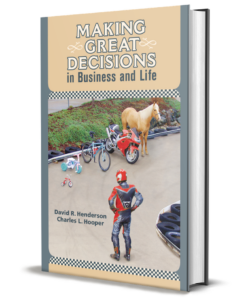
In his book Thinking, Fast and Slow, Daniel Kahneman writes:
As you consider the next question, please assume that Steve was selected at random from a representative sample:
An individual has been described by a neighbor as follows: “Steve is very shy and withdrawn, invariably helpful but with little interest in people or in the world of reality. A meek and tidy soul, he has a need for order and structure, and a passion for detail.” Is Steve more likely to be a librarian or a farmer?
Kahneman continues:
The resemblance of Steve’s personality to that of a stereotypical librarian strikes everyone immediately, but equally relevant statistical considerations are almost always ignored. Did it occur to you that there are more than 20 male farmers for each male librarian in the United States? Because there are so many more farmers, it is almost certain that more “meek and tidy” souls will be found on tractors than at library information desks. However, we found that participants in our experiments ignored the relevant statistical facts and relied exclusively on resemblance. We proposed that they used resemblance as a simplifying heuristic (roughly, a rule of thumb) to make a difficult judgment. The reliance on the heuristic caused predictable biases (systematic errors) in their predictions.
Charley Hooper and I were unaware of Kahneman and Tversky’s experiments, which were run way before we wrote our book, Making Great Decisions in Business and Life, in 2006.
But we gave a similar example in Chapter 6, “Biases Affect the Best of Us.” We put it under the subhead “Check Your Base.” Here it is:
Many people make the mistake of not checking their base. The following example explains what we mean:
Person A: I was surprised that I met this really serious person from California. I thought everyone in California is relaxed and mellow.
Person B: There are 35 million people in California. Many of them are serious.
At a truly national event, such as a scientific conference or a square dancing convention with people from all over the country, you would have a much higher chance of finding a serious person from California than from another state, such as Iowa. This is true even if Iowans in general are more serious; there are just so many more people from California. Say one out of three Californians is serious and that double that fraction of Iowans, that is, two out of three Iowans, are serious. Given California’s population of 35 million and Iowa’s population of three million people, there are about 12 million serious Californians versus only two million serious Iowans. You are six times as likely to come across a serious Californian as a serious Iowan, even though Iowans are twice as likely to be serious. The real question is what you’re doing at a square dancing convention looking for serious people. 🙂

READER COMMENTS
John R. Samborski
Mar 30 2024 at 8:37am
How are people supposed to know how many librarians and farmers there are?
David Henderson
Mar 30 2024 at 11:30am
Good question. It does require a certain level of numeracy plus a sense of the percent of the labor force in farming.
Walter Boggs
Mar 30 2024 at 8:10pm
I suppose it’s more about asking the question than about answering it.
robc
Mar 31 2024 at 12:17am
Google?
Knut P. Heen
Apr 2 2024 at 10:54am
What about comparative advantage or natural selection? It is possible that a certain type of people select into a certain area to such an extent that nothing else matters.
Example. Person X has won a medal in the Winter Olympics. Is it more likely that person X is from Norway or from the United States?
Well, Norway has only 5 million people but more medals of any kind in the Winter Olympics than the United States. The correct answer is Norway. Using the population ratio of the two countries is just another incorrect heuristic.
Robert Simmons
Apr 2 2024 at 3:28pm
A representative sample of what? Americans? My neighbors? Humans across the globe?
Comments are closed.